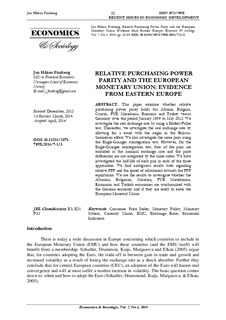Relative purchasing power parity and the European monetary union: Evidence from eastern Europe
Journal article, Peer reviewed
Published version
Permanent lenke
http://hdl.handle.net/11250/2600849Utgivelsesdato
2014Metadata
Vis full innførselSamlinger
- Articles (SAM) [119]
- Publikasjoner fra CRIStin (NHH) [249]
Sammendrag
This paper examine whether relative
purchasing power parity holds for Albania, Bulgaria,
Croatia, FYR Macedonia, Romania and Turkey versus
Germany over the period January 1999 to May 2013. We
investigate the real exchange rate by using a Dickey-Fuller
test. Thereafter, we investigate the real exchange rate by
allowing for a trend with the origin in the BalassaSamuelson effect. We also investigate the same pairs using
the Engle-Granger cointegration test. However, for the
Engle-Granger cointegration test, four of the pairs are
excluded as the nominal exchange rate and the price
differential are not integrated by the same order. We have
investigated the half-life of each pair in each of the three
approaches. We find ambiguous results both regarding
relative PPP and the speed of adjustment towards the PPP
equilibrium. We use the results to investigate whether the
Albanian, Bulgarian, Croatian, FYR Macedonian,
Romanian and Turkish economies are synchronized with
the German economy and if they are ready to enter the
European Monetary Union.

